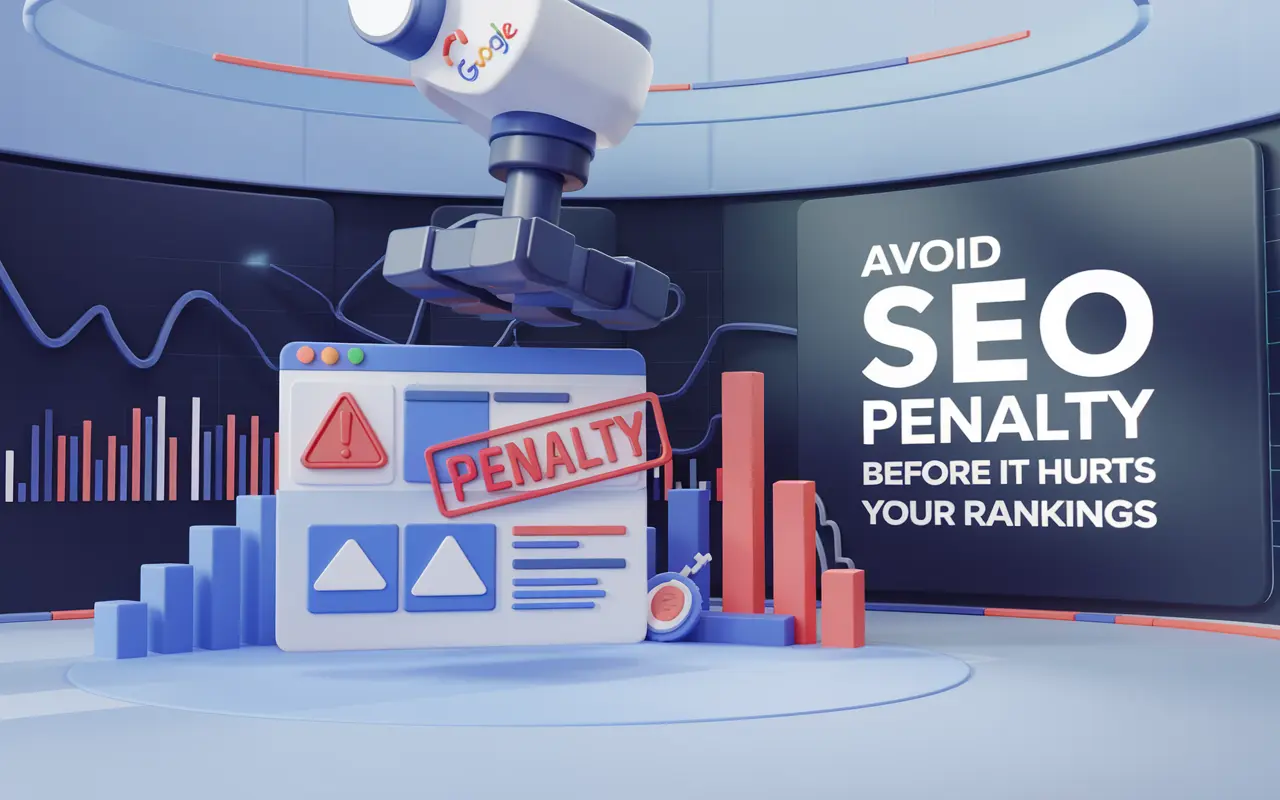Understanding Google Penalty: What Every SEO Needs To Know
In SEO, a Google Penalty refers to a negative impact on a website’s search rankings due to actions that go against Google’s Webmaster Guidelines. These penalties can be either algorithmic or manual and can drastically reduce website traffic and visibility.
With search engines constantly evolving to deliver the best user experience, staying compliant with Google’s rules is crucial. When a penalty is imposed, your site can lose its hard-earned search presence, which can significantly hurt your brand credibility and revenue. Businesses that rely heavily on organic traffic must understand these penalties to maintain stable growth.
Key Takeaway
SEO penalties are detrimental to a site’s search visibility, often triggered by violating guidelines. Staying compliant with best practices ensures long-term organic growth and avoids ranking losses.
Why Google Penalties Matter for SEO Success
Google penalties are a significant component of SEO strategies, as their occurrence usually signals non-compliance with search engine standards. These penalties serve as a warning or enforcement measure to ensure content quality, transparency, and fair competition across the web.
1. Impact on Search Rankings
A penalty can cause a web page—or an entire site—to drop dramatically or disappear from Google’s search results, leading to plummeting organic traffic.
2. Business Revenue and Trust
As traffic drops, so do leads, sales, and conversions. Moreover, users and partners may lose trust in a brand that is penalized, affecting long-term profitability.
3. Recovery Costs Time and Money
Recovering from a penalty requires diagnostics, content and backlink cleanup, possibly redesigning strategies—which can be costly and time-consuming.
Types of Google Penalties in SEO
There are two main types of penalties in SEO, each with its triggers and remediation steps:
| Type | Description | Impact |
|---|---|---|
| Manual Action | Issued by a human reviewer when your site violates Google’s guidelines. | Specific URLs or the entire site may be demoted or deindexed. |
| Algorithmic Penalty | Automatically applied by Google’s ranking algorithms (e.g., Penguin, Panda). | Sudden drop in rankings or organic traffic without notification. |
Best Practices to Avoid Google Penalties
- Quality Content: Always publish unique, informative, and valuable content for users—avoid duplicate or thin content.
- Natural Link Profiles: Earn backlinks organically. Avoid paid links, link farms, or suspicious link schemes.
- Proper Keyword Usage: Avoid keyword stuffing. Integrate keywords naturally into relevant content.
- Follow Google Guidelines: Stay updated with Google’s Webmaster Guidelines.
- Regular SEO Audits: Periodically review your backlink profile, content quality, and technical SEO to ensure compliance.
- Disavow Toxic Links: Use Google’s Disavow Tool to remove spammy or harmful backlinks.
How Google Penalties Work Technically
Manual Penalty
Manual penalties are applied after a manual review by Google’s webspam team. Site owners receive a notification in the Google Search Console explaining the issue and how to fix it. You can submit a reconsideration request once the issue is resolved.
Algorithmic Penalty
Algorithmic penalties are not communicated directly. They occur when Google’s algorithms detect low-quality content or spammy backlinks. Your rankings drop organically, and identifying the root cause requires intensive analysis using tools like Ahrefs or SEMrush.
Case Study: Recovering from a Backlink Penalty
Problem: Sudden Drop in Rankings Due to Unnatural Backlinks
An eCommerce store noticed a 65% drop in organic traffic and sales. Investigation revealed a link-building agency had created hundreds of low-quality backlinks, triggering a Penguin-related algorithmic penalty.
Solution: Link Audit and Disavow Process
The SEO team performed a thorough backlink audit using Ahrefs, identified over 400 harmful backlinks, and submitted a disavow file to Google. They also developed a new content strategy to earn links naturally.
Results: Traffic Regained in 90 Days
Within three months, the site saw a 40% increase in traffic and regained most of its previous ranking positions. Conversions improved by 22% following Google’s re-crawling of the cleaned profile.
Common Mistakes That Lead to Penalties
- Buying Backlinks: Purchasing backlinks from low-quality sources can trigger manual or algorithmic penalties.
- Over-Optimization: Keyword stuffing, excessive anchor text, and manipulative on-page tactics are easily flagged.
- Cloaking and Hidden Text: Showing different content to search engines from what users see can result in a penalty.
- Scraped or Duplicate Content: Copying content from other websites can lead to reduced visibility or complete deindexing.
- Neglecting Site Security: Unsecure (HTTP instead of HTTPS) websites are more likely to be devalued.
Related Terms
- Algorithm Update: Refers to changes in Google’s ranking algorithm, which can cause penalties if a site does not comply with updated standards.
- Backlinks: Links from other websites. Low-quality links can lead to penalties if misused.
- SEO Audit: A diagnostic review to identify SEO issues—including potential risk areas for penalties.
FAQs About SEO Penalty
Common signs include a sudden drop in rankings or traffic, warning notifications in Google Search Console, and de-indexed pages.
You must fix the issues mentioned in the manual action notice, such as removing bad links or spammy content, and submit a reconsideration request to Google.
Recovery can take anywhere from a few weeks to several months, depending on the severity of the penalty and how quickly corrective actions are taken.
No, algorithmic penalties do not trigger warnings. Webmasters need to monitor traffic and ranking patterns to detect them.
Conclusion: Stay Ahead by Avoiding SEO Penalties
SEO penalties can greatly hinder your website’s visibility and credibility online. Whether manual or algorithmic, these penalties are avoidable with ethical SEO practices, regular audits, and high-quality content strategies. By aligning your SEO efforts with Google’s Webmaster Guidelines, your site is more likely to build long-term success and sustainable traffic growth. Stay informed, stay compliant, and let SEO work in your favor—not against you.






